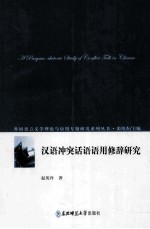

汉语冲突话语语用修辞研究PDF电子书下载
- 电子书积分:12 积分如何计算积分?
- 作 者:赵英玲著
- 出 版 社:长春:东北师范大学出版社
- 出版年份:2011
- ISBN:7560275789
- 页数:328 页
摘要 1
Chapter One Introduction 3
1.1 Conceptualizations 3
1.2 Research questions 9
1.3 Significance 10
1.4 Organizational structure of this study 12
Notes 14
Chapter Two Previous Studies on Argumentative Discourse 17
2.1 Normative study of argument:rhetorical and dialectical perspectives 17
2.1.1 Classical argumentation study of ancient Greek:Aristotle's contribution 17
2.1.2 Toulmin's model 22
2.1.3 Informal logic movement 24
2.2 Normative pragmatics 25
2.2.1 Pragma-dialectics(4) 26
2.2.2 Conversational Argument:The Jackson-Jacobs Model 31
2.3 Descriptive study of argument 33
2.3.1 Content types of conflict talk(5) 35
2.3.2 Oppositional turn construction 36
2.3.3 Closing of conflict talk and conflict talk outcomes 38
2.4 Critical comments 41
Notes 43
Chapter Three Theoretical Framework 47
3.1 Discourse analysis 47
3.1.1 Definitions of discourse analysis 48
3.1.2 Approaches to discourse analysis 50
3.1.3 Conflict talk as a discourse 53
3.2 A Collaborative approach to this study:pragma-rhetoric 53
3.2.1 The marriage of pragmatics and rhetoric 54
3.2.2 Pragma-rhetoric approach to conflict talk 68
Notes 71
Chapter Four Research Procedure and Method 75
4.1 Data collection 75
4.2 Transcription conventions 77
4.3 Data analysis 80
4.4 Research method 82
Notes 83
Chapter Five Sequential Organization of Conflict Talk 87
5.1 An overview:sequence,sequential organization and sequentiality 87
5.2 Sequential organization of initiation 90
5.2.1 Assertion→dissent→dissent 93
5.2.2 Assertion→dissent→repeated assertion 97
5.2.3 Request→refusal→countering the response 98
5.2.4 Accusation→rejection→countering the response 101
5.3 Forms of opposition 105
5.3.1 Negation format 106
5.3.2 Opposing questions 115
5.3.2.1 Rhetorical opposing questions 116
5.3.2.2 Reason-asking question as an oppositional move 129
5.3.3 Substitution format 133
5.3.4 Tit-for-tat format 138
5.3.5 Multiple self-repetition format 143
5.4 Forms of termination 148
5.4.1 Concessions 149
5.4.2 Compromises 156
5.4.3 Frame-breaks 158
5.4.4 Withdrawal format 163
5.4.5 Third party intervention 169
Notes 173
Chapter Six Argumentation Analysis:Rhetorical Reasoning and Argumentation Structure 177
6.1 Reasoning as one of the central components of conflict talk 177
6.2 Forms of inductive reasoning 180
6.2.1 Arguing from analogy(1) 180
6.2.2 Arguing from cause or effect 185
6.2.3 Arguing from examples 187
6.3 Forms of deductive reasoning:syllogism and enthymeme 190
6.4 Forms of fallacies 196
6.4.1 Argumentum ad hominem 197
6.4.2 Argumentum ad baculum 202
6.5 Argumentation structure 207
6.5.1 Tree diagrams:top-down,bottom-up,and mixture 207
6.5.2 Single argumentation,multiple argumentation,coordinate argumentation and subordinate argumentation 213
Notes 220
Chapter Seven Strategies of Conflict Talk Management 223
7.1 Interpersonal rhetoric:politeness involved in conflict talk 224
7.2 Mitigated strategies 226
7.2.1 Agreement tokens 227
7.2.2 Hedges 231
7.2.3 Questions 233
7.3 Moderated strategies 235
7.3.1 Direct disagreement by opposition markers 235
7.3.2 Direct disagreement by substitution 236
7.4 Intensified strategies 237
7.4.1 Upgraders 239
7.4.2 Rhetorical question 241
7.4.3 Uncooperative interruption 243
7.5 Antagonized strategies 249
7.5.1 Verbal aggression 250
7.5.2 Paralinguistic aggression 252
7.5.3 Physical aggression 254
7.6 Frequency of the four kinds of strategies 256
7.7 Reconsidering disagreement as disPreferred act 258
Notes 261
Chapter Eight Types of Conflict Talk and Their Functions 265
8.1 Types of conflict talk 265
8.2 Constructive functions of non-aggressive conflict talk 266
8.2.1 Conflict talk as an inquiry mechanism 267
8.2.2 Conflict talk as an instrument of reflection 269
8.2.3 Conflict talk as a mechanism for working consensus 270
8.3 Destructive functions of aggressive conflict talk 272
8.3.1 Aggressiveness as instrument of venting negative feelings 273
8.3.2 Aggressiveness as instrument of getting power 274
Notes 277
Chapter Nine Conclusion 281
9.1 Summary of major findings 281
9.2 Contributions of this study 286
9.3 Limitations and future research directions 290
Bibliography 293
Acknowledgements 311
Appendix 313
- 《红色旅游的社会效应研究》吴春焕著 2019
- 《汉语词汇知识与习得研究》邢红兵主编 2019
- 《生物质甘油共气化制氢基础研究》赵丽霞 2019
- 《东北民歌文化研究及艺术探析》(中国)杨清波 2019
- 《联吡啶基钌光敏染料的结构与性能的理论研究》李明霞 2019
- 《异质性条件下技术创新最优市场结构研究 以中国高技术产业为例》千慧雄 2019
- 《《国语》和《战国策》词汇比较研究》陈长书著 2017
- 《中国制造业绿色供应链发展研究报告》中国电子信息产业发展研究院 2019
- 《行政保留研究》门中敬著 2019
- 《新课标背景下英语教学理论与教学活动研究》应丽君 2018
- 《大学计算机实验指导及习题解答》曹成志,宋长龙 2019
- 《东北民歌文化研究及艺术探析》(中国)杨清波 2019
- 《大学生心理健康与人生发展》王琳责任编辑;(中国)肖宇 2019
- 《大学英语四级考试全真试题 标准模拟 四级》汪开虎主编 2012
- 《大学英语教学的跨文化交际视角研究与创新发展》许丽云,刘枫,尚利明著 2020
- 《中国地方艺文荟萃 华北东北卷 第1辑 3》《中国地方艺文荟萃》编委会编 2018
- 《中国地方艺文荟萃 华北东北卷 第1辑 1》《中国地方艺文荟萃》编委会编 2018
- 《复旦大学新闻学院教授学术丛书 新闻实务随想录》刘海贵 2019
- 《大学英语综合教程 1》王佃春,骆敏主编 2015
- 《唐代营州与东北边疆经略》宋卿著 2019
